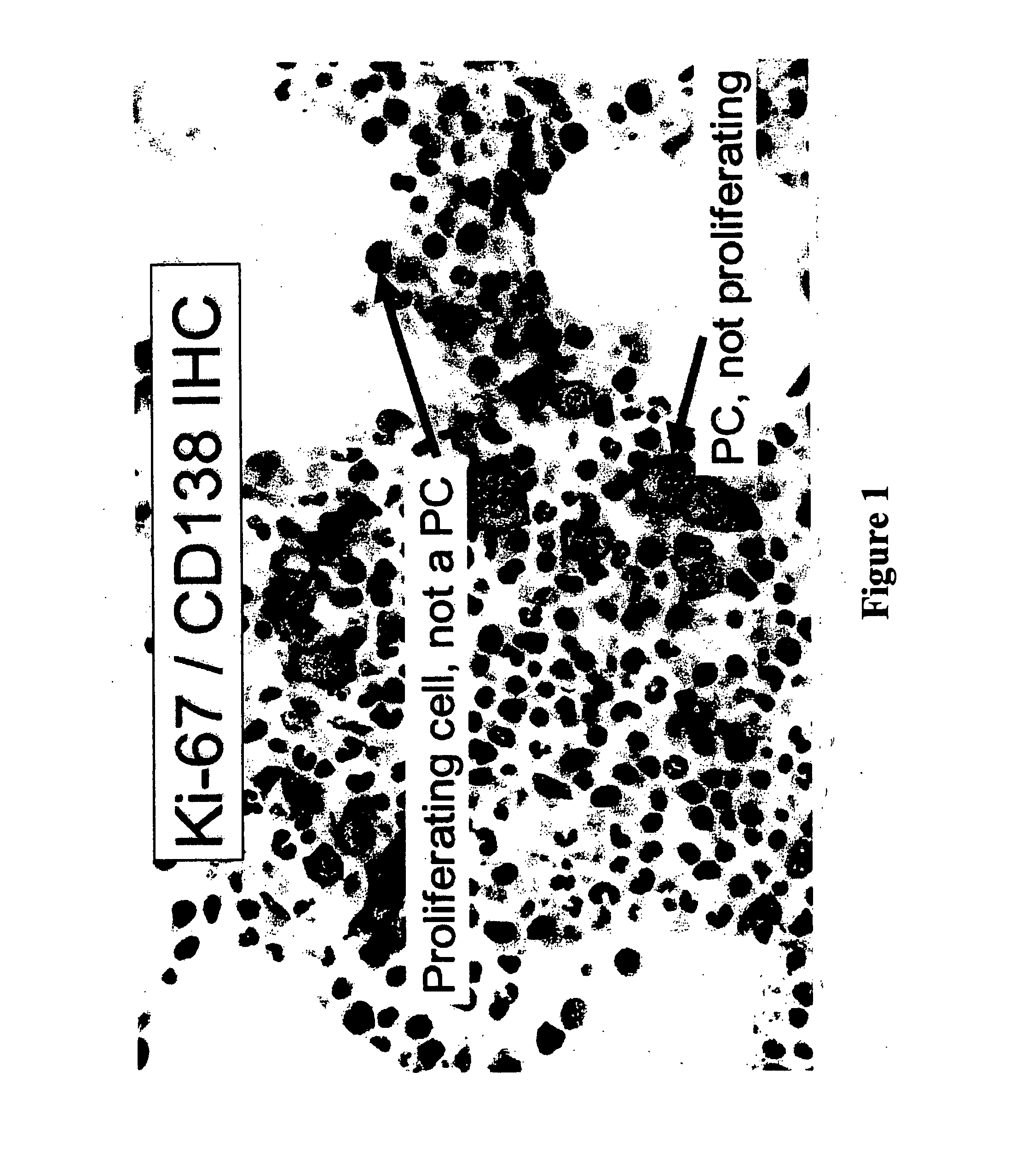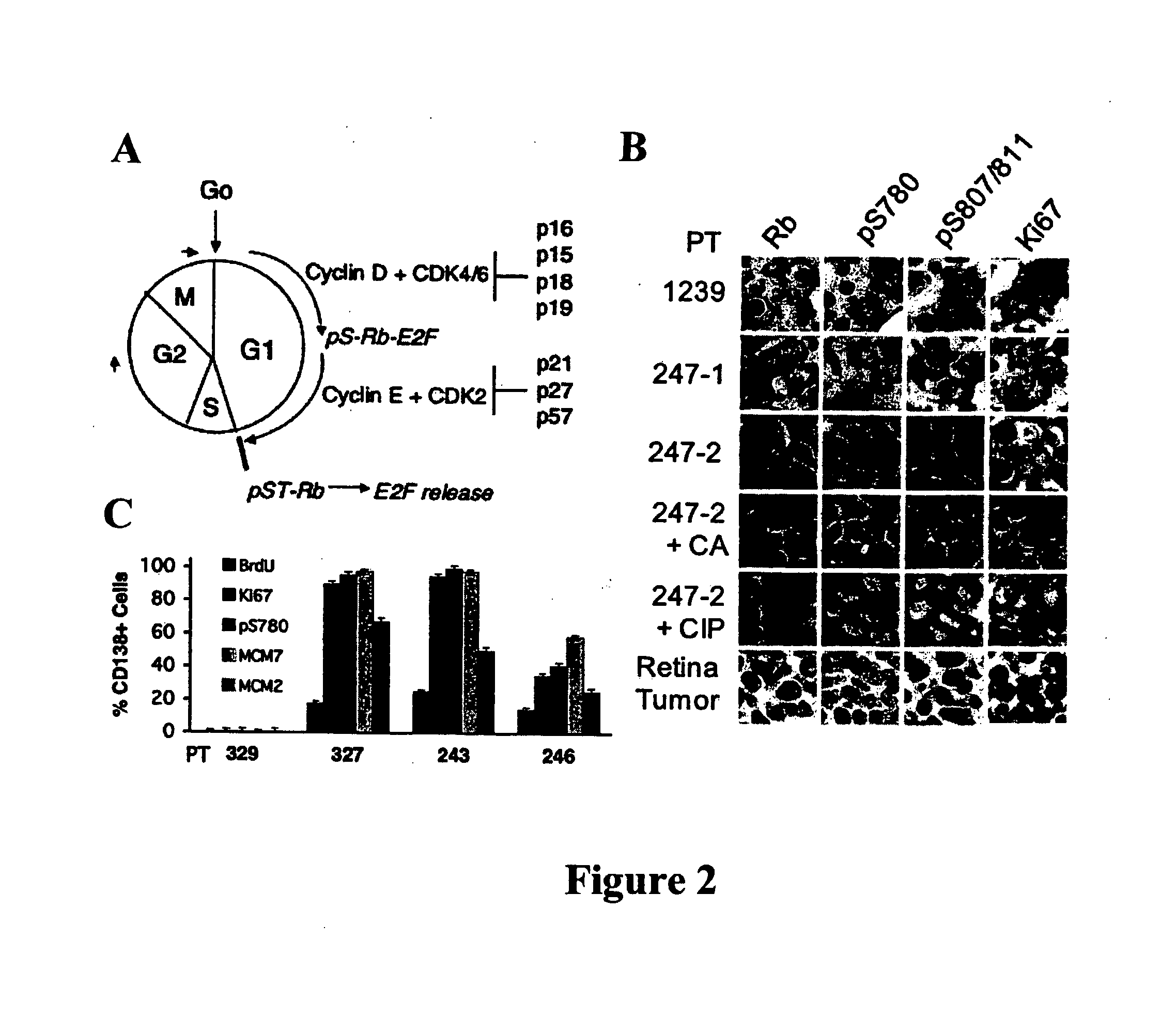Functional Immunohistochemical Cell Cycle Analysis as a Prognostic Indicator for Cancer
a cell cycle analysis and immunohistochemical technology, applied in the field of immunohistochemical cell cycle analysis as a prognostic indicator of cancer, can solve the problems of invariably fatal multi-myeloma, one of the most common lymphoid cancers in adults, and is difficult to predict the outcome of pre-malignant lesions, and the mechanism that underlies the loss of cell cycle control in each cancer type is not understood, so as to achieve the effect of monitoring and predicting treatment
- Summary
- Abstract
- Description
- Claims
- Application Information
AI Technical Summary
Benefits of technology
Problems solved by technology
Method used
Image
Examples
example 1
ow Specimen Procurement
[0055] Bone marrow specimens were obtained from volunteers without hematological disease at the Hospital for Special Surgery and from MM patients at the New York-Presbyterian Hospital under informed consent as part of an Institutional Review Board approved study. The posterior and superior iliac spines were identified before beginning the procedure. The patient was placed in a ventral or lateral decubitus position. The field was cleaned with Betadine and the area of interest was anesthetized with 1% Lidocaine. A bone marrow aspirate and biopsy was performed unilaterally using a modified Jamshidi bone marrow aspiration / biopsy needle, 11 gauge×4 inch. Several 5-7 cc aspirates were obtained by relocating the needle in each aspirate to obtain a total of approximately 30 cc of marrow. The core biopsy was then obtained. The bone marrow core biopsies were fixed in 10% neutral-buffered formalin and paraffin-embedded. CD138+ normal and malignant plasma cells (greater t...
example 2
tochemistry
[0056] Plasma cells were identified with an anti-CD138 antibody and a detection system yielding a red membranous signal. To ensure that hematopoietic background cells did not express CD138 and that all plasma cells in the samples did express CD138, and to ensure that any background non-neoplastic plasma cells were not included in the analysis, the CD138 stained slides in all biopsies were compared to serial sections immunostained for cytoplasmic immunoglobulin expression (IgM, IgD, IgG, IgA, IgK or IgX); these slides were also compared to routine hematoxylin and eosin stained serial sections. The concordance between routine histologic examination, monotypic patient-myeloma isotype specific cytoplasmic immunoglobulin expression, and CD138 expression was very high; rare myeloma specimens showed weak CD138 expression in minor subpopulations of cells but none of the myeloma specimens was negative for CD138. CD138 negative plasma cells were very rare. Non-neoplastic background...
example 3
of BrdU-Uptake
[0064] BrdU uptake in primary bone marrow CD138+ plasma cells ex vivo was detected by immunofluorescence staining (Morse et al., “Induction of Cell Cycle Arrest and B Cell Terminal Differentiation by CDK Inhibitor p18(INK4c) and IL-6,”Immunity 6:47-56 (1997), which is hereby incorporated by reference in its entirety), using a Mab FITC-anti-BrdU (Roche Diagnostics, Indianapolis, Ind.) and Texas red-conjugated rabbit anti-human Ig κ and λ antibodies (Southern Biotechnology). The frequency of BrdU+ cells was determined by counting 250 cells in three areas.
PUM
| Property | Measurement | Unit |
|---|---|---|
| half life | aaaaa | aaaaa |
| pH | aaaaa | aaaaa |
| time | aaaaa | aaaaa |
Abstract
Description
Claims
Application Information
 Login to View More
Login to View More - R&D
- Intellectual Property
- Life Sciences
- Materials
- Tech Scout
- Unparalleled Data Quality
- Higher Quality Content
- 60% Fewer Hallucinations
Browse by: Latest US Patents, China's latest patents, Technical Efficacy Thesaurus, Application Domain, Technology Topic, Popular Technical Reports.
© 2025 PatSnap. All rights reserved.Legal|Privacy policy|Modern Slavery Act Transparency Statement|Sitemap|About US| Contact US: help@patsnap.com



